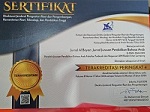The Pronunciation of Egyptian Arabic and Its Aspect of Sociolinguistic
Abstract
Keywords
Full Text:
PDFReferences
Aboelezz, Mariam. “The Politics of Pro-͑āmmiyya Language Ideology in Egypt.” 212–238. Leiden, The Netherlands: Brill, 2017.https://brill.com/view/book/edcoll/9789004346178/B9789004346178-s011.xml.
Agency, Central Intelligence. “The World Factbook,” December 2019. Accessed January 10, 2020. https://www.cia.gov/library/publications/the-world-factbook/geos/eg.html.
Akhmad, Haryono. “Perubahan Dan Perkembangan Bahasa : Tinjauan Historis Dan Sosiolinguistik.” Doctoral Dissertation, Udayana University, 2012.
Al-Wer, Enam, and Uri Horesh. The Routledge Handbook of Arabic Sociolinguistics. New York: Routledge, 2019.
Amrulloh, Muhammad Afif. “Kesamaan Bunyi Pada Sajak (Kajian Fonologi al-Qur’an Dalam Surat al ‘Asar).” Jurnal Al Bayan: Jurnal Jurusan Pendidikan Bahasa Arab 9, no. 1 (2017): 99–109.
Anggito, Albi, and Johan Setiawan. Metodologi Penelitian Kualitatif. Sukabumi: CV Jejak, 2018.
Arsanti, Meilan. “Pemerolehan Bahasa Pada Anak (Kajian Psikolinguistik).” Jurnal PBSI 3, no. 2 (2014): 24–47.
Arslan, C. Ceyhun. “Entanglements between the Tanzimat and Al-Nahḍah: Jurjī Zaydān between Tārīkh Ādāb al-Lughah al-Turkiyyah and Tārīkh Ādāb al-Lughah al-ʿarabiyyah.” Journal of Arabic Literature 50, no. 3–4 (2019): 298–324.
Astari, Rika, and Betty Mauli Rosa Bustam. “A Semantic AnalysisOf Difference Lexical Choices In Quran Translation Of Indonesian And Dutch Versions.” Arabiyat: Jurnal Pendidikan Bahasa Arab dan Kebahasaaraban 6, no. 2 (2019): 302–321.
Astari, Rika, Hadi Syamsul, Soepomo Pudjosudarmo, and Suhandano. “Bentuk Ortografi Istilah Serapan Bahasa Inggris Ke Dalam Bahasa Arab.” Karwistara 4, no. 3 (2014): 224–330.
Astari, Rika, Yusroh, Abdul Malik, Ahmad Arifin bin Sapar, and Nurina Dyah Putrisari. “Padanan Kosakata Arab Dalam Al-Qur’an Terjemah Versi Indonesia Dan Malaysia.” Arabi: Journal of Arabic Studies 5, no. 1 (2020): 63–78.
Astuti, Widi. “Diglossia Pada Penggunaan Bahasa Arab (Kajian Kebahasaan Terhadap Bahasa Fusha Dan Bahasa Amiyah Dilihat Dari Prespektif Sosiolinguistik” 6. Jurnal Komunikasi dan Pendidikan Islam (Desember 2017): 147.
Aziz, Abd. “Landasan Pikir Perdebatan Eksistensi Bahasa Arab Fusha Dan ‘Ammiyah.” Al Amin: Jurnal Kajian Ilmu dan Budaya Islam 2, no. 2 (2019): 117–129.
Bassiouney, Reem. “Language and Identity in Modern Egypt.” Al-ʿArabiyya: Journal of the American Association of Teachers of Arabic, no. 49 (2016): 163–166.
Deterding, David. “Mellisa A. Redford (Ed.), The Handbook of Speech Production. Malden, MA: Wiley-Blackwell, 2015. Pp. Xii 601. ISBN: 978-0-470-65993-9 (Hbk).” Journal of the International Phonetic Association 48, no. 2 (2018): 253–286.
Dzulfikriddin, Muhammah. Sejarah Politik Indonesia: Peran Dan Jasa Mohammad Natsir Dalam Dua Orde Indonesia. Bandung: Mizan Pustaka, 2010.
El Shakry, Hoda. “In the Shadow of World Literature: Sites of Reading in Colonial Egypt , Written by Michael Allan.” Journal of Arabic Literature 48, no. 3 (2017): 345–349.
Eltouhamy, Ibrahim. “Language Attitudes towards Dialects of Arabic in Egypt.” Thesis, the American University in Cairo, 2015.
Eribka Ruthellia, David, Mariam Sondakh, and Stefi Harilama. “Pengaruh Konten Vlog Dalam Youtube Terhadap Pembentukan Sikap Mahasiswa Ilmu Komunikasi Fakultas Ilmu Sosial Dan Politik Universitas Sam Ratulangi.” Acta Diurna Komunikasi 6, no. 1 (2017): 1–18.
Göner, Özlem, and Maria Six-Hohenbalken. “Gender and Memory in the Middle East: On Transgenerational Transmission and Agency.” Dialectical Anthropology 43, no. 2 (June 1, 2019): 157–159.
Hopwood, Derek, Gordon Smith Charles, Arthur Eduard Goldschmidt, Raymond William Baker, Donald P. Little, and Peter M. Holt. “Arab Republic of Egypt, Arab Socialist Republic, Jumhūrīyat Miṣr al-ʿArabīyah, Miṣr.” Encyclopedia Britannica, October 2019. Accessed January 10, 2020. https://www.britannica.com/place/Egypt.
Izzan, Ahmad. Metodologi Pembelajaran Bahasa Arab. Bandung: Humaniora, 2015.
Kushartati, Untung Yuwono, and Multamia RMT Lauder, eds. Pesona Bahasa: Langkah Awal Memahami Linguistik. Jakarta: PT Gramedia Pustaka Utama, 2005.
Long, Michael H, Gisela Granena, and Yucel Yilmaz. “Major Research Issues in Sla.” Brill Research Perspectives in Multilingualism and Second Language Acquisition 1, no. 1 (2016): 1–86.
Misran. “Dialek ‘Ammiyyah Dalam Pengajaran Bahasa Arab Untuk Pariwisata Di Indonesia.” Adabiyyāt: Jurnal Bahasa dan Sastra 12, no. 2 (2013): 398–423.
Montgomery, James E. “Al-Jāḥiẓ on Misarticulation: Bayān 1.34.4-74.8.” Journal of Arabic Literature 49, no. 1–2 (May 2018): 1–22.
Mufrodi. “Fonologi Dan Morfologi Bahasa Arab Amiyah Mesir.” Arabiyat: Jurnal pendidikan Bahasa Arab dan Kebahasaaraban 2, no. 2 (December 2015): 192–215.
Mujib, Ahmad. “Hubungan Bahasa Dan Kebudayaan (Prespektif Sosiolinguistik).” Adabiyyāt: Jurnal Bahasa dan Sastra 8, no. 1 (2009): 141–154.
Muna, Naeila Rifatil. “Psikologi Pembelajaran Bahasa Arab.” El-Ibtikar: Jurnal Pendidikan Bahasa Arab 1, no. 1 (2016): 102–126.
Noupal, Muhammad. “Bahasa Arab ‘Amiyah Dan Fushah Suatu Narasi Deskriptif.” Jurnal Al-Bayan 1, no. 2 (2010): 1–11.
Pancarani, Afridesy Puji, Zaqiatul Mardiah, and Miranda Ariadna Ayu. “Bahasa Amiyah Mesir (sejarah, Kaidah, dan Perbedaannya dengan Bahasa Arab Klasik” 3. jurnal Al Azhar Indonesia Seri Humaniora (March 2016): 205.
Petré, Peter, and Van de Velde Freek. “The Real-Time Dynamics of the Individual and the Community in Grammaticalization.” Linguistic Society of America Language 94, no. 4 (2018): 867–901.
S. Poedjosoedarmo. “Perubahan Bahasa.” In Ceramah Ilmiah Linguistik Pada Pusat Kajian Melayu-Jawa. Fakultas Sastra Universitas Sebelas Maret Surakarta, 2008.
Sholihatin, Anis. “Pemilihan Kode Pada Masyarakat Keturunan Arab Di Nyoyontaan, Kota Pekalongan: Kajian Sosiolinguistik.” Universitas Diponegoro Semarang, 2008.
Siddik, Mohammad. Pengembangan Model Pembelajaran Menulis Deskripsi. Malang: Tunggal Mandiri Publishing, 2018.
Supriyanto, Dedi. “Perbedaan Bahasa Arab Mesir Ragam Fusha Dan Amiyah,” July 10, 2019. Accessed January 6, 2020. https://p4tkbahasa.kemdikbud.go.id/2019/07/10/perbedaan-bahasa-arab-mesir-ragam-fusha-dan-amiyah/.
Thompson, Levi. “Modern Arabic Poetry: Revolution and Conflict, Written by Waed Athamneh.” Journal of Arabic Literature 48, no. 3 (2017): 340–344.
Tohe, Achmad. “Bahasa Arab Fusha Dan Amiyah Serta Problematikanya.” Jurnal Bahasa dan Seni 33 (2005): 202.
Tovar, Sofía Torallas. “Linguistic Identity in Graeco-Roman Egypt.’ The Multilingual Experience in Egypt, from the Ptolemies to the Abbasids.” Routledge (2016): 27–56.
Wahyudi, and Muhammad Ridha. “Urgensi Mempelajari Psikolinguistik Terhadap Pembelajaran Bahasa.” Jurnal Islamika 17, no. 1 (2017): 113–140.
Yendra. Mengenal Ilmu Bahasa (Linguistik). 1st ed. Yogyakarta: Deepublish, 2018.
Yoyo. “Pengaruh Bahasa Arab Terhadap Identitas Sosiokultural Dan Keagamaan Masyarakat Koptik Di Mesir.” Jurnal CMES 10, no. 1 (2017): 1–14.
Yoyo, Abdul Mukhlis, and Thonthowi. “Investigating the Use of Arabic Terms on Sociopolitical Context during the Arab Spring.” In Prosiding Pertemuan Ilmiah Internasional Bahasa Arab, 1263–1273. Aceh, 2018.
Yoyo, Abdul Mukhlis, Thonthowi, and Ferawati. “High Variety vs Low Variety Culture in The Arabic Language : The Tensions between Fushâ and ‘Âmiyya in The Contemporary Arab World.” Arabi : Journal of Arabic Studies 5, no. 1 (2020): 25–32.
DOI: http://dx.doi.org/10.24042/albayan.v12i2.5784
Refbacks
- There are currently no refbacks.
Copyright (c) 2020 Jurnal Al Bayan: Jurnal Jurusan Pendidikan Bahasa Arab
License URL: https://creativecommons.org/licenses/by-sa/4.0
Editorial Office:
Jurnal Al Bayan: Jurnal Jurusan Pendidikan Bahasa Arab, Arabic Education Study Program, Faculty of Education and Teachers Training, Unversitas Islam Negeri Raden Intan Lampung
Jl. Endro Suratmin 1 Sukarame, Bandar Lampung 35131-Indonesia
e-mail: jurnalalbayan@radenintan.ac.id
http://ejournal.radenintan.ac.id/index.php/albayan/index
Jurnal Al Bayan: Jurnal Jurusan Pendidikan Bahasa Arab is licensed under a Creative Commons Attribution-ShareAlike 4.0 International License. p-ISSN 2086-9282 | e-ISSN 2549-1229









